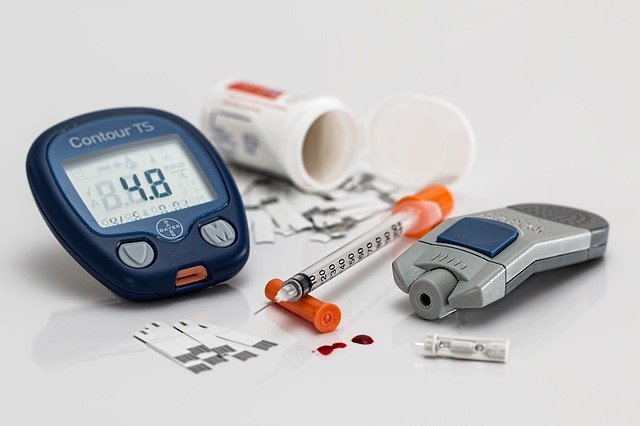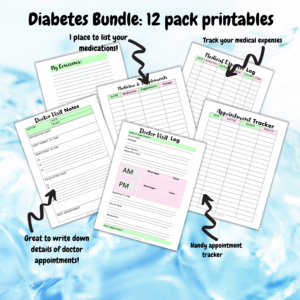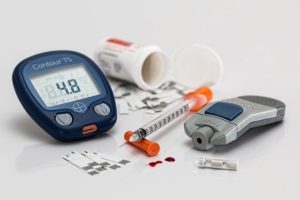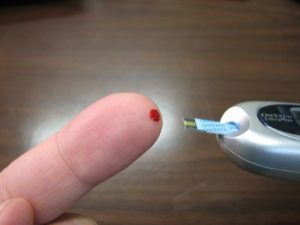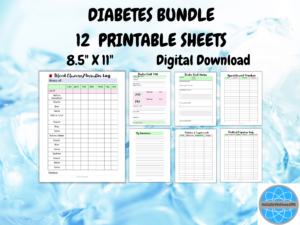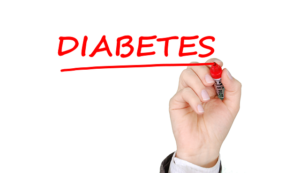This bundle includes everything you need to manage your diabetes. These sheets are perfect to record every detail pertaining to your diabetes.
https://shop.holisticwellnessrn.com/product/diabetes-bundle-12-printable-sheets/
What is Diabetes?
Diabetes is a disease that occurs when your blood glucose levels, also called blood sugar, are abnormal. Diabetes is a disease that affects how the body uses glucose. Blood glucose is your main source of energy and comes from the food you eat.
Insulin, a hormone made by the pancreas, helps glucose from food get into your cells to be used for energy. Sometimes your body doesn’t make enough—or any—insulin or doesn’t use insulin well.
Glucose then stays in your blood and doesn’t reach your cells. Glucose remaining in your blood is what increases your blood sugar levels.
Over time, having too much glucose in your blood can cause health problems.
https://www.niddk.nih.gov/health-information/diabetes/overview/what-is-diabetes
What Happens in Diabetes?
Our bodies break down the foods we eat into glucose and other nutrients we need, which are then absorbed into the bloodstream from the gastrointestinal tract.
The glucose level in the blood rises after a meal and triggers the pancreas to make the hormone insulin and release it into the bloodstream. But in people with diabetes, the body either can’t make or can’t respond to insulin properly.
Types of Diabetes
There are two main types of diabetes: type 1 and type 2.
Both types of diabetes are chronic diseases that affect the way your body regulates blood sugar or glucose. Glucose is the fuel that feeds your body’s cells, but to enter your cells it needs a key. Insulin is that key.
People with type 1 diabetes don’t produce insulin. You can think of it as not having a key.
People with type 2 diabetes don’t respond to insulin as well as they should and later in the disease often don’t make enough insulin. You can think of it as having a broken key.
Both types of diabetes can lead to chronically high blood sugar levels. That increases the risk of diabetes complications.
Diabetes Symptoms
If not managed, type 1 and type 2 diabetes can lead to symptoms such as:
- urinating frequently
- feeling very thirsty and drinking a lot
- feeling very hungry
- feeling very fatigued
- having blurry vision
- having cuts or sores that don’t heal properly
People with type 1 and type 2 diabetes may also experience irritability, mood changes, and unintentional weight loss.
People with type 1 and type 2 diabetes may also have numbness and tingling in their hands or feet.
Although many of the symptoms of type 1 and type 2 diabetes are similar, they present in quite different ways.
Many people with type 2 diabetes won’t have symptoms for many years, and their symptoms often develop slowly over time. Some people with type 2 diabetes have no symptoms at all and don’t discover they have the condition until complications arise.
The symptoms of type 1 diabetes develop quickly, typically over several weeks. Once known as juvenile diabetes, this type usually develops in childhood or adolescence. However, it’s possible to develop type 1 diabetes later in life.
What causes diabetes?
Type 1 and type 2 diabetes may have similar names, but they’re different diseases with unique causes.
Causes of Type 1 Diabetes
The body’s immune system is responsible for fighting off foreign invaders, such as harmful viruses and bacteria.
In people with type 1 diabetes, the immune system mistakes the body’s healthy cells for foreign invaders. The immune system attacks and destroys the insulin-producing beta cells in the pancreas. After these beta cells are destroyed, the body is unable to produce insulin.
Researchers don’t know why the immune system sometimes attacks the body’s cells. It may have something to do with genetic and environmental factors, such as exposure to viruses. Research into autoimmune diseases is ongoing.
Causes of Type 2 Diabetes
People with type 2 diabetes have insulin resistance. The body still produces insulin, but it’s unable to use it effectively.
Researchers aren’t sure why some people become insulin resistant, and others don’t, but several lifestyle factors may contribute, including being inactive and carrying excess weight.
Other genetic and environmental factors may also play a role. When you develop type 2 diabetes, your pancreas will try to compensate by producing more insulin. Because your body is unable to effectively use insulin, glucose will accumulate in your bloodstream.
https://www.mayoclinic.org/diseases-conditions/diabetes/symptoms-causes/syc-20371444
How Common is Diabetes?
Type 2 diabetes is much more common than type 1.
According to the Centers for Disease Control and Prevention’s 2020 National Diabetes Statistics Report Trusted Source, 34.2 million people in the United States were living with diagnosed or undiagnosed diabetes in 2018. That’s a little over 1 in 10 people. Ninety to 95 percent of people with diabetes have type 2.
The percentage of people with diabetes increases with age.
About 10.5 percent of the general population has diabetes. Among those 65 years old and older, the rate reaches 26.8 percent. Only 25 out of every 10,000 Americans under 20 years old had been diagnosed with diabetes in 2018.
Men and women get diabetes at roughly the same rate. However, prevalence rates are higher among certain races and ethnicities.
American Indians, Alaskan Natives, and Mexican Americans have the highest prevalence of diabetes among both men and women. In general, Black, and Hispanic populations have higher rates of diabetes than non-Hispanic whites or non-Hispanic Asians.
Prevalence rates are higher for Hispanic Americans of Mexican or Puerto Rican descent than they are for those of Central and South American or Cuban descent.
Among non-Hispanic Asian Americans, people with Asian Indian ancestry have higher rates of diabetes than people with Chinese or Filipino ancestry.
https://shop.holisticwellnessrn.com/product/diabetes-bundle-12-printable-sheets/
What are the Risk Factors for Type 1 and Type 2 Diabetes?
Risk factors for type 1 diabetes include:
- Family history: People with a parent or sibling with type 1 diabetes have a higher risk of developing it themselves.
- Age: Type 1 diabetes can appear at any age, but it’s most common among children and adolescents.
- Geography: The prevalence of type 1 diabetes increases the farther away you are from the equator.
- Genetics: The presence of certain genes points to an increased risk of developing type 1 diabetes.
You’re at risk of developing type 2 diabetes if you:
- have prediabetes, or slightly elevated blood sugar levels
- are carrying excess weight or have obesity
- have a lot of belly fat
- are physically inactive
- are over age 45
- have ever had gestational diabetes, which is diabetes during pregnancy
- have given birth to a baby weighing more than 9 pounds
- are Black, Hispanic, American Indian, or Alaska Native
- have an immediate family member with type 2 diabetes
- have polycystic ovary syndrome (PCOS)
How are Type 1 and Type 2 Diabetes Diagnosed?
The primary test used to diagnose both type 1 and type 2 diabetes is known as the A1C, or glycated hemoglobin blood test.
This blood test determines your average blood sugar level for the past 2 to 3 months. Your doctor may draw your blood or give you a small finger prick.
The higher your blood sugar levels have been over the past few months, the higher your A1C level will be. Test results are expressed as a percentage. An A1C level of 6.5 percent or higher indicates diabetes.
The A1C test isn’t accurate for people with sickle cell anemia or the sickle cell trait. If you have this condition or trait, then your doctor will have to use a different test.
Diabetes Treatment
There’s no cure for type 1 diabetes. People with type 1 diabetes don’t produce insulin, so it must be regularly injected into the body.
Some people take injections into the soft tissue, such as the stomach, arm, or buttocks, several times per day. Other people use insulin pumps. Insulin pumps supply a steady amount of insulin into the body through a small tube.
Blood sugar testing is an essential part of managing type 1 diabetes because levels can go up and down quickly.
Type 2 diabetes can be managed and may even be reversed with diet and exercise alone, but many people need extra support. If lifestyle changes aren’t enough, your doctor may prescribe medications that help your body use insulin more effectively.
Monitoring your blood sugar is an essential part of type 2 diabetes management too. It’s the only way to know if you’re meeting your target levels.
Your doctor may recommend testing your blood sugar occasionally or more frequently. If your blood sugar levels are high, your doctor may recommend insulin injections.
Which Diets are Recommended for Diabetes?
Nutritional management is an important part of life for people with diabetes.
If you have type 1 diabetes, work with your doctor to identify how much insulin you may need to inject after eating certain types of food.
For example, carbohydrates can cause blood sugar levels to quickly increase in people with type 1 diabetes. You’ll need to counteract this by taking insulin, but you’ll need to know how much insulin to take. Learn more about type 1 diabetes and diet.
People with type 2 diabetes need to focus on healthy eating. Weight loss is often a part of type 2 diabetes treatment plans, so your doctor may recommend a low-calorie meal plan. This could mean reducing your consumption of animal fats and junk food.
Can Diabetes be Prevented?
Type 1 diabetes can’t be prevented.
However, it may be possible to lower your risk of developing type 2 diabetes through these lifestyle changes:
- maintaining a moderate weight
- working with your doctor to develop a healthy weight-loss plan if you are overweight
- increasing your activity levels
- eating a balanced diet and reducing your intake of sugary foods or overly processed foods
Even if you’re unable to prevent the disease itself, careful monitoring can get your blood sugar levels back to normal and prevent the development of serious complications. Complications include low blood sugar, eye and nerve problems, and increased cardiac risks.
Watch for my upcoming posts on how to manage diabetes with lifestyle choices and ways to lower blood sugar levels naturally.

